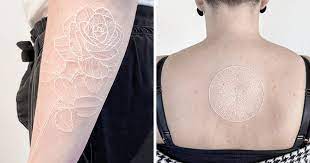
White Tattoos are a relatively recent trend that has quickly gained popularity for their striking yet delicate appearance. Unfortunately, not every skin tone suits these designs, so care must be taken when selecting them.
UV rays
Sunlight can cause white tattoos to fade more rapidly than darker ones due to how their ink reacts with sunlight. This happens because white ink doesn’t contain as many hardy pigments that hold up against sunlight as quickly. Sunlight also causes skin cells to produce more melanin, which can distort a tattoo’s appearance by turning it yellow or brownish and making white designs appear blotchy. Therefore, it is vital to protect white Tattoos from sunlight using sunscreen with SPF 50 or higher, preferably mineral sunscreen, to block UVA and UVB rays. Avoid sunscreens with oxybenzone as it can be absorbed into the bloodstream and increase the risk of allergic reactions or dermatitis.
Scarring
White tattoos can cause scars on the skin due to their natural attempts at keeping ink from running freely across its surface. This process may result in large spots called keloids, which are difficult to treat and sometimes very painful. Itching during the healing process may cause premature breakup of scabs or lead to infections. To ensure proper healing, use a hypoallergenic lotion without dyes or scents. After healing, gently exfoliate the tattoo every few days to remove dead skin cells and avoid damaging the permanent ink.
Changes in skin complexion
Tattoo pigments are foreign substances to your body, prompting white blood cells to attack and break down their ink over time, eventually fading the tattoo and making it look yellower, mimicking skin color more closely. Black Tattoos tend to remain intact more easily. White tattoo ink may turn yellow as it ages, accumulating particles similar to those in natural skin pigmentations. White Tattoos may appear like scarring on darker skin tones, as the dark skin absorbs UV light and makes the white ink less visible.
Aftercare
Tattoos need protection from sun damage and potential irritants during the healing process. Avoid scratching, scrubbing, or traumatizing the tattoo’s surface, as this can fade or alter its colors. Use a cool cloth to gently pat the tattoo instead. Harsh chemicals found in cleaning products can also harm new tattoos. Apply a gentle, unscented lotion or ointment four times daily for optimal care. Avoid petroleum and thick oils, which can clog the skin and prevent effective moisture absorption. After 5-7 days, switch to a water-based, nonscented lotion. Let the tattoo naturally peel and allow scabs to fall off without picking, as picking can cause permanent scarring. Seek medical attention if you experience severe pain, blisters, burning sensations, or any discharge from the tattoo.

